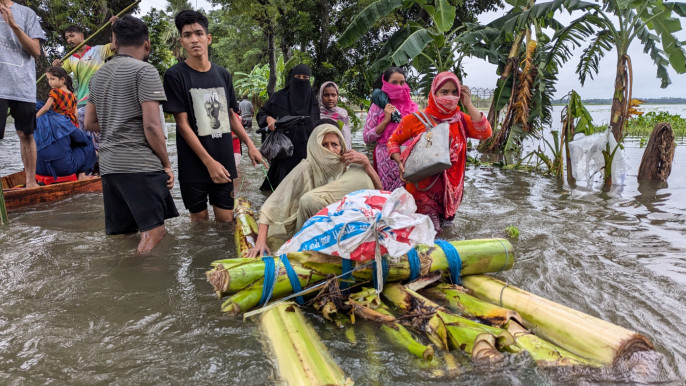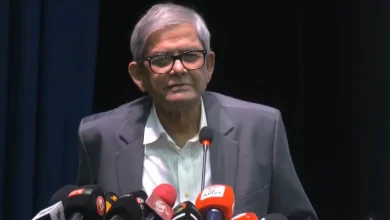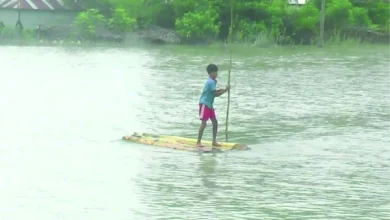3 killed, lakhs stranded with no power as ten districts flooded

Flood waters likely to reduce after Saturday
A person tows a raft made of banana trees with an elderly woman on board as local people wade through knee-deep water while others use a boat to move to safer places to escape rushing flood waters at Abupur under Feni sadar upazila on Thursday. Flood waters submerged several other districts including Noakhali, Lakshmipur, Cumilla, Moulvibazar, Sylhet and Khagrachari. Photo: Zakir Hossain Chowdhury
Heavy rainfall and upstream water flow from India have caused severe flooding in at least ten districts of southeastern Bangladesh, affecting over 36 lakh people since Tuesday.
Cumilla, Feni, Chattogram, Khagrachhari, Noakhali, Moulvibazar, Habiganj, Brahmanbaria, Sylhet, and Lakshmipur remain heavily inundated, with hundreds of thousands of residents still stranded.
As of 10pm on Thursday (22 August), three deaths were reported from Feni, Brahmanbaria and Cox’s Bazar’s Ramu due to the floods.
At 9pm, the water level of the Khawai River at the Balla Station in Habiganj was recorded at 2.77 metres above the danger level. Additionally, the Khawai at the Habiganj Station saw water levels 1.76 metres higher than usual. Similarly, the Gomati River at the Cumilla Station was flowing 1.36 metres above the danger level.
The water level of the Gomati River was rising rapidly, with an increase of 5-7 centimetres per hour.
Hundreds of thousands of people in Feni were left stranded without electricity. Elsewhere, knee-deep water inundated the Dhaka-Chattogram highway.
According to the Bangladesh Meteorological Department (BMD), there is a high chance of heavy to very heavy rainfall in most parts of the country until noon today. While rainfall is expected to reduce in Sylhet and Chattogram within the afternoon, the BMD predicted that rainfall may increase in Khulna and Rajshahi regions.
On Thursday, the highest recorded rainfall was 275mm in Cox’s Bazar till 6pm. Cumilla recorded 194mm, Rangamati 153mm, Chattogram 152mm, Sitakunda 118mm, Chandpur 110mm, and Bandarban 84mm rainfall.
The Flood Forecasting and Warning Centre (FFWC) of the Bangladesh Water Development Board said the water levels of most rivers in Sylhet and Chattogram were rising rapidly until Thursday morning.
However, the levels began to recede in the afternoon due to decreased rainfall throughout the day, except in the Gomati River in Cumilla, where water levels remain high.
Situation in Feni
Floodwaters from the broken embankments of the Muhuri, Kahua, and Silonia rivers in Feni have flooded the region, leaving lakhs of people trapped and without electricity.
The lack of connectivity has aggravated the suffering of those affected by the disaster.
Since Monday night, most areas of Parshuram, Fulgazi, and Chhagalnaiya upazilas have been without electricity due to damage to the power lines caused by the floodwaters.
As the situation deteriorated, power was completely shut off in these three upazilas, as well as parts of Sonagazi and Dagonbhuiyan upazilas. Additionally, due to waterlogging in Feni town caused by heavy rainfall, electricity was turned off from noon until late at night.
Hawladar Fazlur Rahman, general manager of Feni Rural Electrification Board, said that out of the district’s four lakh customers, more than three lakhs are without electricity. Heavy rain has damaged power lines in various areas.
Alamgir Hossain, sub-divisional engineer of Feni Power Development Board, mentioned that approximately 70% of their customers are without power.
Government efforts
As per data from the Ministry of Disaster Management and Relief, floods have affected at least 495 unions in 65 upazilas across 10 districts, leaving around 586,040 families stranded by floodwaters.
To accommodate those displaced by the floods, 2,246 shelters have been opened, providing refuge to 82,694 people and 7,755 livestock. Additionally, 492 medical teams have been deployed to provide healthcare services in the affected districts.
The disaster management ministry has allocated Tk3.32 crore in cash, 19,650 metric tonnes of rice, and 15,000 packets of dry food for relief efforts.
The army has started rescue operations with speedboats to evacuate people stranded in the flood-affected areas. In addition, members of the Border Guard Bangladesh (BGB) and hundreds of volunteers from district volunteer organisations were conducting rescue operations and providing food assistance throughout the day, on Thursday.
The deputy commissioners in the affected areas have been instructed to coordinate with Anti-Discrimination Student Movement coordinators, the army, navy, BGB, medical teams, and other volunteers to work together on relief efforts.
A round-the-clock control room has been set up by the Ministry of Disaster Management and Relief.
Rain in some places likely to reduce after Saturday
BMD Meteorologist Shahnaz Sultana told The Business Standard, “Heavy rainfall may continue upstream for the next two days. However, the tendency for heavy rain within Bangladesh, particularly in the regions of Sylhet, Feni, Cumilla, and Chattogram, is expected to decrease from Friday [today] afternoon, while rainfall is likely to increase in Khulna and Kolkata.”
FFWC Executive Engineer Sarder Udoy Raihan told TBS, “The intensity of this flood is greater than previous ones in this area, primarily due to excessive rainfall and upstream flooding. The rising water levels in the rivers are making it difficult for the upstream water from India to drain away easily.”
“However, except for the Gomati River, the tendency for rising water levels in other rivers slightly decreased on Thursday. Improved weather conditions in India’s Tripura, and in Cumilla, Feni, and Chattogram have contributed to a slower rise in water levels,” he added.
He further said, “Water levels in most of these rivers are expected to remain largely unchanged until Friday [today] noon, with some rivers seeing slight increases or decreases. Within the next 72 hours, water levels in most rivers are likely to fall below the danger level.”
Why did Bangladesh face a sudden flood?
Experts and meteorologists said the record rainfall in India’s Tripura state and the release of water from an Indian dam were key factors behind the severe floods in Bangladesh.
These events overwhelmed Bangladesh’s rivers, leading to the catastrophic flooding in the affected districts, they added.
Manjur A Chowdhury, former chairman for Centre for Governance Studies and National River Conservation Commission (NRCC), told The Business Standard, “Any dam on a river is harmful to Bangladesh. The sudden release of water from Indian dams, combined with heavy rainfall, has aggravated the flood situation. Although India shares information about river water levels, it does not notify Bangladesh before opening the dams.”
“With weather forecasts available 15-20 days in advance, India could have anticipated the abnormal rainfall in August. They should have gradually released the stored water earlier, which might have prevented such devastating floods in both Tripura and Bangladesh. When the dam is closed, a significant amount of water is stored behind it,” he added.
He also criticised the current state of Bangladesh’s rivers, which have been narrowed due to so-called dredging, reducing their capacity to hold and flow water. “This is a major reason why the floods have been so prolonged,” he said.
Sarwar Mahmud, chairman NRCC, said, “One of the main reasons for the floods is the upstream water flow. The combined effect of rainwater and upstream water from India is putting immense pressure on the rivers in Bangladesh.”
“Around 80-90% of the water in our rivers comes from neighbouring countries. Furthermore, the navigability of most of our rivers is not properly maintained. The necessary dredging to maintain navigability is not being done; instead, only the channels are being maintained.”






